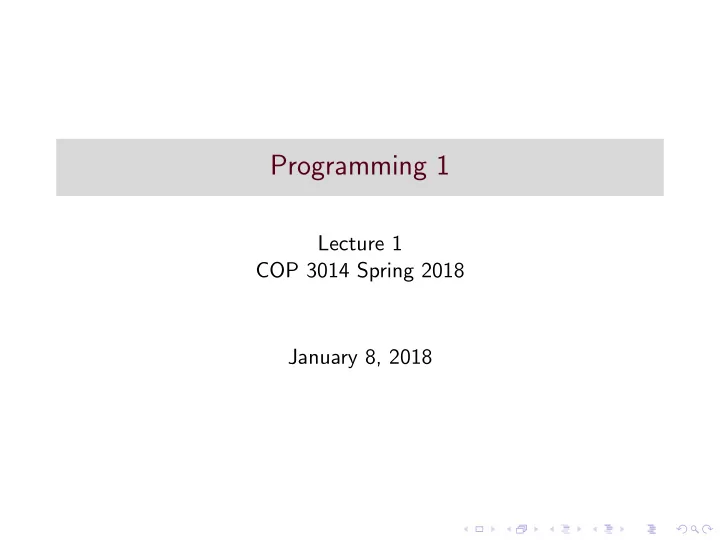

Programming 1 Lecture 1 COP 3014 Spring 2018 January 8, 2018
We have technology!
Main Components of a computer ◮ CPU - Central Processing Unit: The “brain” of the computer. ◮ ISA - Instruction Set Architecture: the specific set of low-level instructions available to a CPU. Differs for various CPU types (Intel Pentium, Mac G4, etc). ◮ ALU - Arithmetic & Logic Unit responsible for performing arithmetic calculations, as well as logical operations (comparisons for equality, inequality, for instance). ◮ Main Memory (RAM - Random Access Memory). ◮ storage close to CPU ◮ Faster to access than hard disk ◮ stores executing programs and data being currently worked on ◮ Secondary Memory ◮ SSD, hard disk, DVD, etc.
Main Components of a computer ◮ Input devices ◮ mouse, keyboard, scanner, network card, etc. ◮ Output devices ◮ screen/console, printer, network card, etc. ◮ Operating System ◮ Examples: Mac OS, Windows 10, Linux ◮ Controls computer operations ◮ Manages allocation of resources for currently running applications
Memory Concepts ◮ bit: a binary digit ◮ Stores the value 0 or 1 ◮ Smallest unit of storage in a computer ◮ byte: 8 bits ◮ Smallest addressable unit of storage in a computer ◮ Storage units (variables) in a program are 1 or more bytes ◮ Each byte in memory has an address (a number that identifies the location)
Programming, and Programming Languages Program - a set of instructions for a computer to execute Evolution of Programming languages ◮ Machine Language ◮ Based on machine’s core instruction set ◮ Needed by computer, hard for humans to read (1’s and 0’s) ◮ Example: 1110110101010110001101010
Programming, and Programming Languages ◮ Assembly Language ◮ translation of machine instructions to symbols, slightly easier for humans to read ◮ Example: ADD $R1, $R2, $R3
Programming, and Programming Languages ◮ High-level procedural languages ◮ Abstraction of concepts into more human-readable terms ◮ Closer to ”natural language” (i.e. what we speak) ◮ Easy to write and design, but must be translated for computer ◮ Examples include C, Pascal, Fortran ◮ Object-oriented languages ◮ Abstraction taken farther than procedural languages ◮ Objects model real-world objects, not only storing data (attributes), but having inherent behaviors (operations, functions) ◮ Easier to design and write good, portable, maintainable code ◮ Examples include Smalltalk, C++, Java
Code Translation Bridging the gap between high-level code and machine code ◮ Interpreted languages – source code is directly run on an interpreter, a program that runs the code statements ◮ Compiled Languages ◮ A compiler program translates source code (what the programmer writes) to machine language (object code) ◮ A linker program puts various object code files together into an executable program (or other target type, like a DLL) ◮ C and C++ are compiled languages
Software Development Involves more than just writing code
Software Development ◮ Analysis and problem definition ◮ Design - includes design of program or system structure, algorithms, user-interfaces, and more ◮ Implementation (coding) ◮ Testing - can be done during design, during implementation, and after implementation ◮ Maintenance - usually the major cost of a software system. Not part of ”development”, but definitely part of the software life cycle
Programming is about Problem Solving
Programming is about Problem Solving ◮ Algorithm - a finite sequence of steps to perform a specific task ◮ To solve a problem, you have to come up with the necessary step-by-step process before you can code it ◮ This is often the trickiest part of programming ◮ Some useful tools and techniques for formulating an algorithm ◮ Top-down Refinement: Decomposing a task into smaller and simpler steps, then breaking down each step into smaller steps, etc ◮ Pseudocode: Writing algorithms informally in a mixture of natural language and general types of code statements ◮ Flowcharting: If you can visualize it, it’s often easier to follow and understand!
Programming is about Problem Solving ◮ Testing - algorithms must also be tested! ◮ Does it do what is required? ◮ Does it handle all possible situations? ◮ Syntax vs. Semantics ◮ Syntax – the grammar of a language. A syntax error: ”I is a programmer.” ◮ Semantics – the meaning of language constructs Correct syntax, but a semantic error: ”The headphones ate the tree.”
Basic Creation and Execution of a C++ program ◮ Create source code with a text editor, store to disk. ◮ Source code is just a plain text file, usually given a filename extension to identify the programming language (like .c for C, or .cpp for C++) ◮ Preprocessor – Part of compiler process, performs any pre-processing tasks on source code. ◮ Compilation – syntax checking, creation of object code. ◮ Object code is the machine code translation of the source code. ◮ Linking – Final stage of the creation of an executable program. Linking of object code files together with any necessary libraries (also already compiled). ◮ Execution of program ◮ Program loaded into memory, usually RAM ◮ CPU executes code instructions
Software Required for the Class ◮ The recommended software is JetBrains CLiom ◮ You can find it at https://www.jetbrains.com/clion/buy . ◮ Under the “Discounted and Complementary Licenses” tab, choose “For Students and Teachers” and apply for a free license for and All Products Pack. ◮ You will get an email from JetBrains. Follow along with the instructions and you will be asked to create a JetBrains account. Upon doing that, you will get a key. ◮ You can then Download and Install CLion. Please follow the HowToCLion document on the Software page of the course website for instructions on installing and using the software. ◮ You can also use XCode, Visual Studio, etc. However, if you do so, please keep in mind that the TA’s will use CLion to grade. ◮ You can also create an account on the CS department programming servers, and use a text editor and the g++ compiler to run your code.
Recommend
More recommend